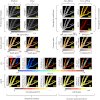Quantitative photoacoustic microscopy of optical absorption coefficients from acoustic spectra in the optical diffusive regime
- PMID: 22734767
- PMCID: PMC3381032
- DOI: 10.1117/1.JBO.17.6.066011
Quantitative photoacoustic microscopy of optical absorption coefficients from acoustic spectra in the optical diffusive regime
Abstract
Photoacoustic (PA) microscopy (PAM) can image optical absorption contrast with ultrasonic spatial resolution in the optical diffusive regime. Conventionally, accurate quantification in PAM requires knowledge of the optical fluence attenuation, acoustic pressure attenuation, and detection bandwidth. We circumvent this requirement by quantifying the optical absorption coefficients from the acoustic spectra of PA signals acquired at multiple optical wavelengths. With the acoustic spectral method, the absorption coefficients of an oxygenated bovine blood phantom at 560, 565, 570, and 575 nm were quantified with errors of <3%. We also quantified the total hemoglobin concentration and hemoglobin oxygen saturation in a live mouse. Compared with the conventional amplitude method, the acoustic spectral method provides greater quantification accuracy in the optical diffusive regime. The limitations of the acoustic spectral method was also discussed.
Figures




References
-
- Zhang H. F., et al. , “Imaging of hemoglobin oxygen saturation variations in single vessels in vivo using photoacoustic microscopy,” Appl. Phys. Lett. 90(5), 053901 (2007).APPLAB10.1063/1.2435697 - DOI
-
- Wang L. V., Wu H., Biomedical Optics: Principles and Imaging, Wiley, Hoboken, NJ: (2007).
Publication types
MeSH terms
Substances
Grants and funding
LinkOut - more resources
Full Text Sources
Other Literature Sources
Miscellaneous

